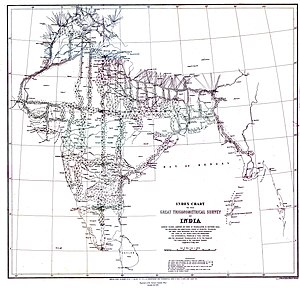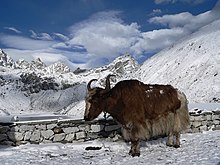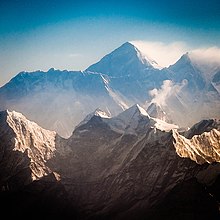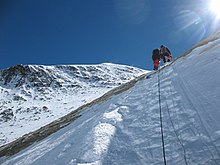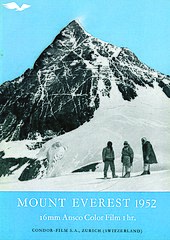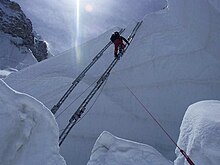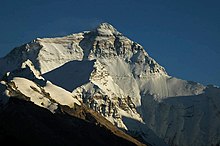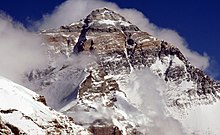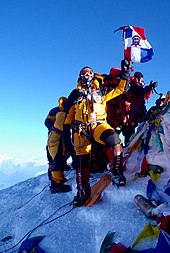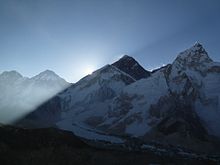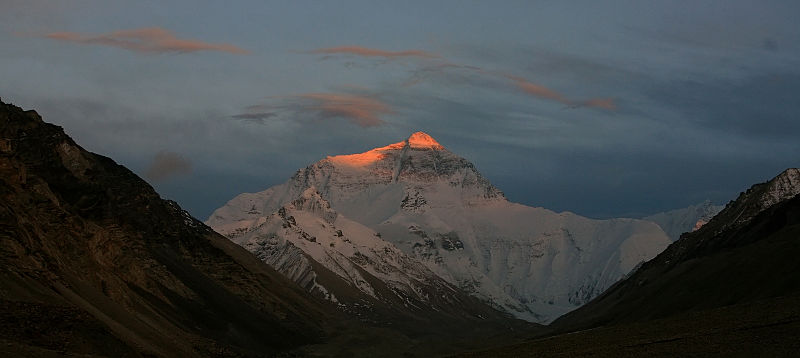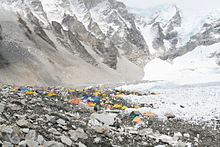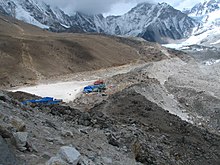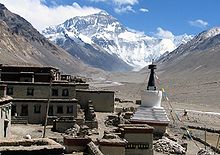In 1856, the Great Trigonometrical Survey of India established the first published height of Everest, then known as Peak XV, at 8,840 m (29,002 ft). The current official height of 8,848 m (29,029 ft) as recognised by China and Nepal was established by a 1955 Indian survey and subsequently confirmed by a Chinese survey in 1975. In 1865, Everest was given its official English name by the Royal Geographical Society upon a recommendation by Andrew Waugh, the British Surveyor General of India. Waugh named the mountain after his predecessor in the post, Sir George Everest, arguing that there were many local names, against the opinion of Everest.[10]
Mount Everest attracts many highly experienced mountaineers as well as capable climbers willing to hire professional guides. There are two main climbing routes, one approaching the summit from the southeast in Nepal (known as the standard route) and the other from the north in Tibet. While not posing substantial technical climbing challenges on the standard route, Everest presents dangers such as altitude sickness, weather, wind as well as significant objective hazards from avalanches and the Khumbu Icefall. As of 2016, there are well over 200 corpses still on the mountain, with some of them even serving as landmarks.[11][12]
The first recorded efforts to reach Everest's summit were made by British mountaineers. With Nepal not allowing foreigners into the country at the time, the British made several attempts on the north ridge route from the Tibetan side. After the first reconnaissance expedition by the British in 1921 reached 7,000 m (22,970 ft) on the North Col, the 1922 expedition pushed the North ridge route up to 8,320 m (27,300 ft) marking the first time a human had climbed above 8,000 m (26,247 ft). Tragedy struck on the descent from the North col when seven porters were killed in an avalanche. The 1924 expedition resulted in the greatest mystery on Everest to this day: George Mallory and Andrew Irvine made a final summit attempt on June 8 but never returned, sparking debate as to whether they were the first to reach the top. They had been spotted high on the mountain that day but disappeared in the clouds, never to be seen again, until Mallory's body was found in 1999 at 8,155 m (26,755 ft) on the North face. Tenzing Norgay and Edmund Hillary made the first official ascent of Everest in 1953 using the southeast ridge route. Tenzing had reached 8,595 m (28,199 ft) the previous year as a member of the 1952 Swiss expedition. The Chinese mountaineering team of Wang Fuzhou, Gonpo and Qu Yinhua made the first reported ascent of the peak from the North Ridge
Discovery
A map showing the triangles and transects used in the Great
Trigonometric Survey of India, this map produced in 1870. The Great
Trigonometrical Survey of India was started in April 1802
Location on Earth
Mount Everest relief map
Morning view of Mount Everest from its southern side
From Kala Patthar
The British were forced to continue their observations from Terai, a region south of Nepal which is parallel to the Himalayas. Conditions in Terai were difficult because of torrential rains and malaria. Three survey officers died from malaria while two others had to retire because of failing health.[15]
Nonetheless, in 1847, the British continued the Great Trigonometric survey and began detailed observations of the Himalayan peaks from observation stations up to 240 km (150 mi) away. Weather restricted work to the last three months of the year. In November 1847, Andrew Waugh, the British Surveyor General of India made several observations from the Sawajpore station located in the eastern end of the Himalayas. Kangchenjunga was then considered the highest peak in the world, and with interest he noted a peak beyond it, about 230 km (140 mi) away. John Armstrong, one of Waugh's officials, also saw the peak from a location farther west and called it peak "b". Waugh would later write that the observations indicated that peak "b" was higher than Kangchenjunga, but given the great distance of the observations, closer observations were required for verification. The following year, Waugh sent a survey official back to Terai to make closer observations of peak "b", but clouds thwarted all attempts.[15]
In 1849, Waugh dispatched James Nicolson to the area, who made two observations from Jirol, 190 km (120 mi) away. Nicolson then took the largest theodolite and headed east, obtaining over 30 observations from five different locations, with the closest being 174 km (108 mi) from the peak.[15]
Nicolson retreated to Patna on the Ganges to perform the necessary calculations based on his observations. His raw data gave an average height of 9,200 m (30,200 ft) for peak "b", but this did not consider light refraction, which distorts heights. However, the number clearly indicated that peak "b" was higher than Kangchenjunga. Then, Nicolson contracted malaria and was forced to return home without finishing his calculations. Michael Hennessy, one of Waugh's assistants, had begun designating peaks based on Roman numerals, with Kangchenjunga named Peak IX, while peak "b" now became known as Peak XV.[15]
In 1852, stationed at the survey headquarters in Dehradun, Radhanath Sikdar, an Indian mathematician and surveyor from Bengal, was the first to identify Everest as the world's highest peak, using trigonometric calculations based on Nicolson's measurements.[16] An official announcement that Peak XV was the highest was delayed for several years as the calculations were repeatedly verified. Waugh began work on Nicolson's data in 1854, and along with his staff spent almost two years working on the calculations, having to deal with the problems of light refraction, barometric pressure, and temperature over the vast distances of the observations. Finally, in March 1856 he announced his findings in a letter to his deputy in Calcutta. Kangchenjunga was declared to be 8,582 m (28,156 ft), while Peak XV was given the height of 8,840 m (29,002 ft). Waugh concluded that Peak XV was "most probably the highest in the world".[15] Peak XV (measured in feet) was calculated to be exactly 8,839.2 m (29,000 ft) high, but was publicly declared to be 8,839.8 m (29,002 ft) in order to avoid the impression that an exact height of 8,839.2 metres (29,000 ft) was nothing more than a rounded estimate (in feet).[17] Waugh is therefore wittily credited with being "the first person to put two feet on top of Mount Everest".
Name
While the survey wanted to preserve local names if possible (e.g. Kangchenjunga and Dhaulagiri), Waugh argued that he could not find any commonly used local name. Waugh's search for a local name was hampered by Nepal and Tibet's exclusion of foreigners. Many local names existed, including "Deodungha" ("Holy Mountain") in Darjeeling[18] and the Tibetan "Chomolungma", which appeared on a 1733 map published in Paris by the French geographer D'Anville. In the late 19th century, many European cartographers incorrectly believed that a native name for the mountain was Gaurishankar, which is a mountain between Kathmandu and Everest.[19]Waugh argued that because there were many local names, it would be difficult to favour one name over all others, so he decided that Peak XV should be named after Welsh surveyor Sir George Everest, his predecessor as Surveyor General of India.[15][20][21] Everest himself opposed the name suggested by Waugh and told the Royal Geographical Society in 1857 that "Everest" could not be written in Hindi nor pronounced by "the native of India". Waugh's proposed name prevailed despite the objections, and in 1865, the Royal Geographical Society officially adopted Mount Everest as the name for the highest mountain in the world.[15] The modern pronunciations of Everest (/ˈɛvərᵻst/ and /ˈɛvrᵻst/)[22] are different from Sir George's pronunciation of his surname (/ˈiːvrᵻst/, EEV-rist).[23]
The Tibetan name for Mount Everest is ཇོ་མོ་གླང་མ (IPA: [t͡ɕʰòmòlɑ́ŋmɑ̀],[citation needed] lit. "Holy Mother"), whose official Tibetan pinyin form is Qomolangma. It is also popularly romanised as Chomolungma and (in Wylie) as Jo-mo-glang-ma or Jomo Langma.[28] The official Chinese transcription is 珠穆朗玛峰 (t 珠穆朗瑪峰), whose pinyin form is Zhūmùlǎngmǎ Fēng ("Chomolungma Peak").[29] It is also infrequently simply translated into Chinese as Shèngmǔ Fēng (t 聖母峰, s 圣母峰, lit. "Holy Mother Peak"). In 2002, the Chinese People's Daily newspaper published an article making a case against the use of "Mount Everest" in English, insisting that the mountain should be referred to as "Mount Qomolangma",[29] based on the official form of the local Tibetan name. The article argued that British colonialists did not "first discover" the mountain, as it had been known to the Tibetans and mapped by the Chinese as "Qomolangma" since at least 1719.[30]
In the early 1960s, the Nepalese government coined a Nepali name for Mount Everest, Sagarmāthā or Sagar-Matha[31] (सगरमाथा),[32] allegedly to supplant the Tibetan name among the locals, a usage which the Nepali government felt was "not acceptable".[citation needed]
Surveys
Published by the Survey of Nepal, this is Map 50 of the 57 map set at
1:50,000 scale "attached to the main text on the First Joint Inspection
Survey, 1979–80, Nepal-China border." At the top centre, note the
boundary line, identified as separating "China" and "Nepal", passing
exactly through the summit contour. The boundary here and for much of
the China-Nepal border follows the main Himalayan watershed divide.
In 1856, Andrew Waugh announced Everest (then known as Peak XV) as 8,840 m (29,002 ft) high, after several years of calculations based on observations made by the Great Trigonometric Survey.
The elevation of 8,848 m (29,029 ft) was first determined by an Indian survey in 1955, made closer to the mountain, also using theodolites.[citation needed] It was subsequently reaffirmed by a 1975 Chinese measurement of 8,848.13 m (29,029.30 ft).[35] In both cases the snow cap, not the rock head, was measured. In May 1999 an American Everest Expedition, directed by Bradford Washburn, anchored a GPS unit into the highest bedrock. A rock head elevation of 8,850 m (29,035 ft), and a snow/ice elevation 1 m (3 ft) higher, were obtained via this device.[36] Although it has not been officially recognised by Nepal,[37] this figure is widely quoted. Geoid uncertainty casts doubt upon the accuracy claimed by both the 1999 and 2005 surveys.
A detailed photogrammetric map (at a scale of 1:50,000) of the Khumbu region, including the south side of Mount Everest, was made by Erwin Schneider as part of the 1955 International Himalayan Expedition, which also attempted Lhotse. An even more detailed topographic map of the Everest area was made in the late 1980s under the direction of Bradford Washburn, using extensive aerial photography.[38]
On 9 October 2005, after several months of measurement and calculation, the Chinese Academy of Sciences and State Bureau of Surveying and Mapping officially announced the height of Everest as 8,844.43 m (29,017.16 ft) with accuracy of ±0.21 m (8.3 in). They claimed it was the most accurate and precise measurement to date.[39] This height is based on the actual highest point of rock and not on the snow and ice covering it. The Chinese team also measured a snow/ice depth of 3.5 m (11 ft),[35] which is in agreement with a net elevation of 8,848 m (29,029 ft). The snow and ice thickness varies over time, making a definitive height of the snow cap impossible to determine.
2004 photo mosaic the Himalayas with Makalu and Mount Everest from the International Space Station, Expedition 8.
Comparisons
By the same measure of base to summit, Denali, in Alaska, formerly known as Mount McKinley, is also taller than Everest.[43] Despite its height above sea level of only 6,190 m (20,308 ft), Denali sits atop a sloping plain with elevations from 300 to 900 m (980 to 2,950 ft), yielding a height above base in the range of 5,300 to 5,900 m (17,400 to 19,400 ft); a commonly quoted figure is 5,600 m (18,400 ft).[44][45] By comparison, reasonable base elevations for Everest range from 4,200 m (13,800 ft) on the south side to 5,200 m (17,100 ft) on the Tibetan Plateau, yielding a height above base in the range of 3,650 to 4,650 m (11,980 to 15,260 ft).[38]
The summit of Chimborazo in Ecuador is 2,168 m (7,113 ft) farther from Earth's centre (6,384.4 km (3,967.1 mi)) than that of Everest (6,382.3 km (3,965.8 mi)), because Earth bulges at the Equator.[46] This is despite Chimborazo having a peak 6,268 m (20,564.3 ft) above sea level versus Mount Everest's 8,848 m (29,028.9 ft).
Geology
Mount Everest with snow melted, showing upper geologic layers in bands.
The "yellow band" can be seen stretching across the mountain.
Mount Everest lit up with sunshine at the peak. This is a view of the north face.
The Qomolangma Formation, also known as the Jolmo Lungama Formation or the Everest Formation,[49] runs from the summit to the top of the Yellow Band, about 8,600 m (28,200 ft) above sea level. It consists of grayish to dark gray or white, parallel laminated and bedded, Ordovician limestone inter layered with subordinate beds of recrystallised dolomite with argillaceous laminae and siltstone. Gansser first reported finding microscopic fragments of crinoids in this limestone.[50][51] Later petrographic analysis of samples of the limestone from near the summit revealed them to be composed of carbonate pellets and finely fragmented remains of trilobites, crinoids, and ostracods. Other samples were so badly sheared and recrystallised that their original constituents could not be determined. A thick, white-weathering thrombolite bed that is 60 m (200 ft) thick comprises the foot of the "Third Step", and base of the summit pyramid of Everest. This bed, which crops out starting about 70 m (230 ft) below the summit of Mount Everest, consists of sediments trapped, bound, and cemented by the biofilms of micro-organisms, especially cyanobacteria, in shallow marine waters. The Qomolangma Formation is broken up by several high-angle faults that terminate at the low angle normal fault, the Qomolangma Detachment. This detachment separates it from the underlying Yellow Band. The lower five meters of the Qomolangma Formation overlying this detachment are very highly deformed.[47][48][52]
The bulk of Mount Everest, between 7,000 and 8,600 m (23,000 and 28,200 ft), consists of the North Col Formation, of which the Yellow Band forms its upper part between 8,200 to 8,600 m (26,900 to 28,200 ft). The Yellow Band consists of intercalated beds of Middle Cambrian diopside-epidote-bearing marble, which weathers a distinctive yellowish brown, and muscovite-biotite phyllite and semischist. Petrographic analysis of marble collected from about 8,300 m (27,200 ft) found it to consist as much as five percent of the ghosts of recrystallised crinoid ossicles. The upper five meters of the Yellow Band lying adjacent to the Qomolangma Detachment is badly deformed. A 5–40 cm (2.0–15.7 in) thick fault breccia separates it from the overlying Qomolangma Formation.[47][48][52]
The remainder of the North Col Formation, exposed between 7,000 to 8,200 m (23,000 to 26,900 ft) on Mount Everest, consists of interlayered and deformed schist, phyllite, and minor marble. Between 7,600 and 8,200 m (24,900 and 26,900 ft), the North Col Formation consists chiefly of biotite-quartz phyllite and chlorite-biotite phyllite intercalated with minor amounts of biotite-sericite-quartz schist. Between 7,000 and 7,600 m (23,000 and 24,900 ft), the lower part of the North Col Formation consists of biotite-quartz schist intercalated with epidote-quartz schist, biotite-calcite-quartz schist, and thin layers of quartzose marble. These metamorphic rocks appear to be the result of the metamorphism of Middle to Early Cambrian deep sea flysch composed of interbedded, mudstone, shale, clayey sandstone, calcareous sandstone, graywacke, and sandy limestone. The base of the North Col Formation is a regional low-angle normal fault called the "Lhotse detachment".[47][48][52]
Below 7,000 m (23,000 ft), the Rongbuk Formation underlies the North Col Formation and forms the base of Mount Everest. It consists of sillimanite-K-feldspar grade schist and gneiss intruded by numerous sills and dikes of leucogranite ranging in thickness from 1 cm to 1,500 m (0.4 in to 4,900 ft).[48][53] These leucogranites are part of a belt of Late Oligocene–Miocene intrusive rocks known as the Higher Himalayan leucogranite. They formed as the result of partial melting of Paleoproterozoic to Ordovician high-grade metasedimentary rocks of the Higher Himalayan Sequence about 20 to 24 million years ago during the subduction of the Indian Plate.[54]
Everest, Khumbu Glacier, Kumbu Icefall
Flora and fauna
See also: Organisms at high altitude
A yak at around 4790 m (15715 ft) altitude
Euophrys omnisuperstes, a minute black jumping spider, has been found at elevations as high as 6,700 metres (22,000 ft), possibly making it the highest confirmed non-microscopic permanent resident on Earth. It lurks in crevices and may feed on frozen insects that have been blown there by the wind. It should be noted that there is a high likelihood of microscopic life at even higher altitudes.[63] Birds, such as the bar-headed goose, have been seen flying at the higher altitudes of the mountain, while others, such as the chough, have been spotted as high as the South Col at 7,920 metres (25,980 ft).[64] Yellow-billed choughs have been seen as high as 7,900 metres (26,000 ft) and the aforementioned bar-headed geese migrate over the Himalayas.[65] As early as 1953, George Lowe on the famous expedition of Tenzing and Hillary noted seeing the geese fly over Mount Everest.[66]
Yaks are often used to haul gear for Mount Everest climbs; they can haul 100 kg (220 pounds), and have thick fur and big lungs.[62] One common piece of advice for those in the Everest region is to be on higher ground when around yaks and other animals, as they can knock people off the mountain if standing on the downhill edge of a trail.[67] Other animals in the region include the Himalayan tahr which is sometimes eaten by the snow leopard.[68] The Himalayan black bear can be found up to about 4,300 metres (14,000 ft) and the red panda is also in the region.[69] One science expedition found a surprising range of species in the region including a pika that eats its own faeces and ten new species of ants.[70]
Environment
| Atmospheric pressure comparison | Pressure | Reference | |
|---|---|---|---|
| kilopascal | psi | ||
| Olympus Mons summit | 0.03 | 0.0044 | – |
| Mars average | 0.6 | 0.087 | – |
| Hellas Planitia bottom | 1.16 | 0.168 | – |
| Armstrong limit | 6.25 | 0.906 | – |
| Mount Everest summit | 33.7 | 4.89 | [71] |
| Earth sea level | 101.3 | 14.69 | – |
| Dead Sea level | 106.7 | 15.48 | [72] |
| Surface of Venus | 9,200 | 1,330 | [73] |
Looking at Everest and Lhotse from the south. In the foreground are Thamserku, Kantega, and Ama Dablam
In the summer, the Indian monsoon brings warm wet air from the Indian ocean to Everest's south side. During the winter the West/South-West flowing jet stream shifts south and blows on the peak.[81]
History of expeditions
Climbers pass by the Yellow Band
Overview
It was finally known to have been summited by 1953, but it remained a difficult peak for decades.[82] Despite the effort and attention poured into expeditions, it was only summited by about 200 people by 1987.[82] Everest showed itself to be a difficult place for decades, even for serious attempts by professional climbers and large national expeditions, which were the norm until the commercial era picked up in the 1990s.[83]By March 2012, Everest had been climbed 5,656 times with 223 deaths.[84] Although lower mountains can be longer or steeper climbs, Everest is so high the jet stream can hit it. Climbers can be faced with winds beyond 320 km/h (200 mph) when the weather shifts.[85] At certain times of the year the jet stream shifts north, providing periods of relative calm at the mountain.[86] Other dangers include blizzards and avalanches.[86]
By 2013, the Himalayan database recorded 6,871 summits by 4,042 different people.[87]
Early attempts
In 1885, Clinton Thomas Dent, president of the Alpine Club, suggested that climbing Mount Everest was possible in his book Above the Snow Line.[88]The northern approach to the mountain was discovered by George Mallory and Guy Bullock on the initial 1921 British Reconnaissance Expedition. It was an exploratory expedition not equipped for a serious attempt to climb the mountain. With Mallory leading (and thus becoming the first European to set foot on Everest's flanks) they climbed the North Col to an altitude of 7,005 metres (22,982 ft). From there, Mallory espied a route to the top, but the party was unprepared for the great task of climbing any further and descended.
The British returned for a 1922 expedition. George Finch ("The other George") climbed using oxygen for the first time. He ascended at a remarkable speed—290 metres (951 ft) per hour, and reached an altitude of 8,320 m (27,300 ft), the first time a human reported to climb higher than 8,000 m. This feat was entirely lost on the British climbing establishment—except for its "unsporting" nature. Mallory and Col. Felix Norton made a second unsuccessful attempt. Mallory was faulted for leading a group down from the North Col which got caught in an avalanche. Mallory was pulled down too, but seven native porters were killed.
The next expedition was in 1924. The initial attempt by Mallory and Geoffrey Bruce was aborted when weather conditions precluded the establishment of Camp VI. The next attempt was that of Norton and Somervell, who climbed without oxygen and in perfect weather, traversing the North Face into the Great Couloir. Norton managed to reach 8,550 m (28,050 ft), though he ascended only 30 m (98 ft) or so in the last hour. Mallory rustled up oxygen equipment for a last-ditch effort. He chose young Andrew Irvine as his partner.
1952 documentary
In 1933, Lady Houston, a British millionairess, funded the Houston Everest Flight of 1933, which saw a formation of aircraft led by the Marquess of Clydesdale fly over the summit in an effort to deploy the British Union Flag at the top.[89][90][91]
Early expeditions—such as General Charles Bruce's in the 1920s and Hugh Ruttledge's two unsuccessful attempts in 1933 and 1936—tried to make an ascent of the mountain from Tibet, via the north face. Access was closed from the north to western expeditions in 1950, after China asserted control over Tibet. In 1950, Bill Tilman and a small party which included Charles Houston, Oscar Houston and Betsy Cowles undertook an exploratory expedition to Everest through Nepal along the route which has now become the standard approach to Everest from the south.[92]
The Swiss expedition of 1952, led by Edouard Wyss-Dunant, was granted permission to attempt a climb from Nepal. The expedition established a route through the Khumbu ice fall and ascended to the South Col at an elevation of 7,986 m (26,201 ft). No attempt at an ascent of Everest was ever under consideration in this case.[93] Raymond Lambert and Sherpa Tenzing Norgay were able to reach a height of about 8,595 m (28,199 ft) on the southeast ridge, setting a new climbing altitude record. Tenzing's experience was useful when he was hired to be part of the British expedition in 1953.[94]
First successful ascent by Tenzing and Hillary
Main article: 1953 British Mount Everest expedition
In 2015 two mountain ranges on Pluto were named for them, Norgay Montes and Hillary Montes (greyscale image)
News of the expedition's success reached London on the morning of Queen Elizabeth II's coronation, 2 June. Returning to Kathmandu a few days later, Hunt (a Briton) and Hillary (a New Zealander) discovered that they had been promptly knighted in the Order of the British Empire for the ascent.[96] Tenzing, a Nepali sherpa who was a citizen of India, was granted the George Medal by the UK. Hunt was ultimately made a life peer in Britain, while Hillary became a founding member of the Order of New Zealand.[97] Hillary and Tenzing are also nationally recognised in Nepal, where annual ceremonies in schools and offices celebrate their accomplishment.[citation needed][98]
The next successful ascent was on 23 May 1956 by Ernst Schmied and Juerg Marmet.[99] This was followed by Dölf Reist and Hans-Rudolf von Gunten on 24 May 1957.[99] Wang Fuzhou, Gonpo and Qu Yinhua of China made the first reported ascent of the peak from the North Ridge on 25 May 1960.[13][14] The first American to climb Everest, Jim Whittaker, joined by Nawang Gombu, reached the summit on 1 May 1963.[100][101]
Routes
Mt. Everest has two main climbing routes, the southeast ridge from Nepal and the north ridge from Tibet, as well as many other less frequently climbed routes.[102] Of the two main routes, the southeast ridge is technically easier and is the more frequently used route. It was the route used by Edmund Hillary and Tenzing Norgay in 1953 and the first recognised of fifteen routes to the top by 1996.[102] This was, however, a route decision dictated more by politics than by design as the Chinese border was closed to the western world in the 1950s after the People's Republic of China invaded Tibet.[103]
View from space showing South Col route and North Col/Ridge route
Southeast ridge
The ascent via the southeast ridge begins with a trek to Base Camp at 5,380 m (17,700 ft) on the south side of Everest in Nepal. Expeditions usually fly into Lukla (2,860 m) from Kathmandu and pass through Namche Bazaar. Climbers then hike to Base Camp, which usually takes six to eight days, allowing for proper altitude acclimatization in order to prevent altitude sickness.[106] Climbing equipment and supplies are carried by yaks, dzopkyos (yak-cow hybrids) and human porters to Base Camp on the Khumbu Glacier. When Hillary and Tenzing climbed Everest in 1953, the British expedition that they were part of (over 400 climbers, porters and sherpas at that point) started from the Kathmandu Valley, as there were no roads further east at that time.Climbers spend a couple of weeks in Base Camp, acclimatizing to the altitude. During that time, Sherpas and some expedition climbers set up ropes and ladders in the treacherous Khumbu Icefall. Seracs, crevasses and shifting blocks of ice make the icefall one of the most dangerous sections of the route. Many climbers and Sherpas have been killed in this section. To reduce the hazard, climbers usually begin their ascent well before dawn, when the freezing temperatures glue ice blocks in place. Above the icefall is Camp I at 6,065 metres (19,900 ft).
Climber traversing Khumbu Icefall
From ABC, climbers ascend the Lhotse face on fixed ropes up to Camp III, located on a small ledge at 7,470 m (24,500 ft). From there, it is another 500 meters to Camp IV on the South Col at 7,920 m (26,000 ft). From Camp III to Camp IV, climbers are faced with two additional challenges: the Geneva Spur and the Yellow Band. The Geneva Spur is an anvil shaped rib of black rock named by the 1952 Swiss expedition. Fixed ropes assist climbers in scrambling over this snow-covered rock band. The Yellow Band is a section of interlayered marble, phyllite, and semischist, which also requires about 100 meters of rope for traversing it.[107]
On the South Col, climbers enter the death zone. Climbers typically only have a maximum of two or three days that they can endure at this altitude for making summit bids. Clear weather and low winds are critical factors in deciding whether to make a summit attempt. If weather does not cooperate within these short few days, climbers are forced to descend, many all the way back down to Base Camp.
A view of Everest southeast ridge base camp. The Khumbu Icefall can be seen on the left. In the centre are the remnants of a helicopter that crashed in 2003.
Panoramic view of Sagarmatha National Park-Gorak Shep to Pheriche.
Khumbu icefall and Mount Everest are on the right side of the picture.
Kangshung Face (the east face) as seen from orbit
Hillary and Tenzing were the first climbers to ascend this step and they did it with primitive ice climbing equipment and ropes. Nowadays, climbers ascend this step using fixed ropes previously set up by Sherpas. Once above the step, it is a comparatively easy climb to the top on moderately angled snow slopes—though the exposure on the ridge is extreme, especially while traversing large cornices of snow. With increasing numbers of people climbing the mountain in recent years, the Step has frequently become a bottleneck, with climbers forced to wait significant amounts of time for their turn on the ropes, leading to problems in getting climbers efficiently up and down the mountain. After the Hillary Step, climbers also must traverse a loose and rocky section that has a large entanglement of fixed ropes that can be troublesome in bad weather. Climbers typically spend less than half an hour at the summit to allow time to descend to Camp IV before darkness sets in, to avoid serious problems with afternoon weather, or because supplemental oxygen tanks run out.
North ridge route
See also: Three Steps
Mount Everest north face from Rongbuk in Tibet
Summit
A view from the summit of Mount Everest in May 2013
Below the summit there is an area known as "rainbow valley", filled with dead bodies still wearing brightly coloured winter gear.[112] Down to about 8000 meters is an area commonly called the "death zone", due to the high danger and low oxygen because of the low pressure.[78] The summit penetrates the stratosphere, the next major layer in the atmosphere above the troposphere.[78]
Below the summit the mountain slopes downward to the three main sides, or faces, of Mount Everest: the North Face, the South-West Face, and the East/Kangshung Face.[113]
Death zone
Main article: Death zone
The summit of Mount Everest from the North side
Another significant threat to climbers is low atmospheric pressure. The atmospheric pressure at the top of Everest is about a third of sea level pressure or 0.333 standard atmospheres (337 mbar), resulting in the availability of only about a third as much oxygen to breathe.[114]
Debilitating effects of the death zone are so great that it takes most climbers up to 12 hours to walk the distance of 1.72 kilometres (1.07 mi) from South Col to the summit.[115] Achieving even this level of performance requires prolonged altitude acclimatization, which takes 40–60 days for a typical expedition. A sea-level dweller exposed to the atmospheric conditions at the altitude above 8,500 m (27,900 ft) without acclimatization would likely lose consciousness within 2 to 3 minutes.[116]
In May 2007, the Caudwell Xtreme Everest undertook a medical study of oxygen levels in human blood at extreme altitude. Over 200 volunteers climbed to Everest Base Camp where various medical tests were performed to examine blood oxygen levels. A small team also performed tests on the way to the summit.[117] Even at base camp, the low partial pressure of oxygen had direct effect on blood oxygen saturation levels. At sea level, blood oxygen saturation is generally 98–99%. At base camp, blood saturation fell to between 85 and 87%. Blood samples taken at the summit indicated very low oxygen levels in the blood. A side effect of low blood oxygen is a vastly increased breathing rate, often 80–90 breaths per minute as opposed to a more typical 20–30. Exhaustion can occur merely attempting to breathe.[118]
Lack of oxygen, exhaustion, extreme cold, and climbing hazards all contribute to the death toll. An injured person who cannot walk is in serious trouble, since rescue by helicopter is generally impractical and carrying the person off the mountain is very risky. People who die during the climb are typically left behind. As of 2006, about 150 bodies had never been recovered. It is not uncommon to find corpses near the standard climbing routes.[119]
Debilitating symptoms consistent with high altitude cerebral oedema commonly present during descent from the summit of Mount Everest. Profound fatigue and late times in reaching the summit are early features associated with subsequent death.A 2008 study noted that the "death zone" is indeed where most Everest deaths occur, but also noted that most deaths occur during descent from the summit.[121] A 2014 article in the magazine The Atlantic about deaths on Everest noted that while falling is one of the greatest dangers the DZ presents for all 8000ers, avalanches are a more common cause of death at lower altitudes.[122] However, Everest climbing is more deadly than Base jumping, although some have combined extreme sports and Everest including a beverage company that had someone base-jumping off Everest in a wingsuit (they did survive though).[123][124]
— Mortality on Mount Everest, 1921-2006: descriptive study[120]
Despite this, Everest is safer for climbers than a number of peaks by some measurements, but it depends on the period.[125] Some examples are Kangchenjunga, K2, Annapurna, Nanga Parbat, and the Eiger (especially the nordwand).[125] Mont Blanc has more deaths each year than Everest, with over one hundred dying in a typical year and over eight thousand killed since records were kept.[126] Some factors that affect total mountain lethality include the level of popularity of the mountain, the skill of those climbing, and of course the difficulty of the climb.[126]
Another health hazard is retinal haemorrhages, which can damage eyesight and cause blindness.[127] Up to a quarter of Everest climbers can experience retinal haemorrhages, and although they usually heal within weeks of returning to lower altitudes, in one case a climber went blind and ended up dying in the death zone.[127]
At one o'clock in the afternoon, the British climber Peter Kinloch was on the roof of the world, in bright sunlight, taking photographs of the Himalayas below, "elated, cheery and bubbly". But Mount Everest is now his grave, because only minutes later, he suddenly went blind and had to be abandoned to die from the cold.
— A. McSmith[127]
Supplemental oxygen
Climber at the summit wearing an oxygen mask
Brain cells are extremely sensitive to a lack of oxygen. Some brain cells start dying less than 5 minutes after their oxygen supply disappears. As a result, brain hypoxia can rapidly cause severe brain damage or death.The use of bottled oxygen to ascend Mount Everest has been controversial. It was first used on the 1922 British Mount Everest Expedition by George Finch and Geoffrey Bruce who climbed up to 7,800 m (25,600 ft) at a spectacular speed of 1000 vertical feet per hour (vf/h). Pinned down by a fierce storm, they escaped death by breathing oxygen from a jury-rigged set-up during the night. The next day they climbed to 8,100 m (26,600 ft) at 900 vf/h—nearly three times as fast as non-oxygen users. Yet the use of oxygen was considered so unsportsmanlike that none of the rest of the Alpine world recognised this high ascent rate.[citation needed] George Mallory himself described the use of such oxygen as unsportsmanlike, but he later concluded that it would be impossible for him to summit without it and consequently used it on his final attempt in 1924.[133] When Tenzing and Hillary made the first successful summit in 1953, they used bottled oxygen, with the expedition's physiologist Griffith Pugh referring to the oxygen debate as a "futile controversy", noting that oxygen "greatly increases subjective appreciation of the surroundings, which after all is one of the chief reasons for climbing."[134] For the next twenty-five years, bottled oxygen was considered standard for any successful summit.
— Healthline Website[130]
.. although an acclimatised lowlander can survive for a time on the summit of Everest without supplemental oxygen, one is so close to the limit that even a modicum of excess exertion may impair brain function.Reinhold Messner was the first climber to break the bottled oxygen tradition and in 1978, with Peter Habeler, made the first successful climb without it. In 1980, Messner summited the mountain solo, without supplemental oxygen or any porters or climbing partners, on the more difficult northwest route. Once the climbing community was satisfied that the mountain could be climbed without supplemental oxygen, many purists then took the next logical step of insisting that is how it should be climbed.[135]
— Thomas F. Hornbein in The high-altitude brain [132]
The aftermath of the 1996 disaster further intensified the debate. Jon Krakauer's Into Thin Air (1997) expressed the author's personal criticisms of the use of bottled oxygen. Krakauer wrote that the use of bottled oxygen allowed otherwise unqualified climbers to attempt to summit, leading to dangerous situations and more deaths. The disaster was partially caused by the sheer number of climbers (34 on that day) attempting to ascend, causing bottlenecks at the Hillary Step and delaying many climbers, most of whom summitted after the usual 2 pm turnaround time. He proposed banning bottled oxygen except for emergency cases, arguing that this would both decrease the growing pollution on Everest—many bottles have accumulated on its slopes—and keep marginally qualified climbers off the mountain.
The 1996 disaster also introduced the issue of the guide's role in using bottled oxygen.[136] Guide Anatoli Boukreev's decision not to use bottled oxygen was sharply criticised by Jon Krakauer. Boukreev's supporters (who include G. Weston DeWalt, who co-wrote The Climb) state that using bottled oxygen gives a false sense of security.[137] Krakauer and his supporters point out that, without bottled oxygen, Boukreev could not directly help his clients descend.[138] They state that Boukreev said that he was going down with client Martin Adams,[138] but just below the South Summit, Boukreev determined that Adams was doing fine on the descent and so descended at a faster pace, leaving Adams behind. Adams states in The Climb: "For me, it was business as usual, Anatoli's going by, and I had no problems with that."[139]
The low oxygen can cause a mental fog-like impairment of cognitive abilities described as "delayed and lethargic thought process, clinically defined as bradypsychia" even after returning to lower altitudes.[140] In severe cases, climbers can experience hallucinations. Some studies have found that high-altitude climbers, including Everest climbers, experience altered brain structure.[140] The effects of high altitude on the brain, particularly if it can cause permanent brain damage, continue to be studied.[140]
Selected climbing records
Main article: Timeline of climbing Mount Everest
The Khumbu Icefall in 2005
The Western Cwm ("Coom"), with Everest on the left and Lhotse to the right
- 1922 – First climb to 8,000 metres (26,247 ft), by George Finch and Captain Geoffrey Bruce[142]
- 1952 – First climb to South Col by 1952 Swiss Mount Everest expedition
- 1953 – First ascent, by Tenzing Norgay and Edmund Hillary on 1953 British Mount Everest expedition
- 1960 – First reported ascent from the North Ridge by Wang Fuzhou, Gonpo and Qu Yinhua of China.[13][14]
- 1975 – First female ascent, by Junko Tabei (16 May).[141][143]
- 1975 - First female ascent from the North Ridge, by Phantog, deputy head of the second Chinese Everest expedition that sent nine climbers to the summit (27 May).[144][145][146]
- 1978 – First ascent without supplemental oxygen by Reinhold Messner and Peter Habeler[147]
- 1980 – First solo ascent, by Reinhold Messner[147]
- 1980 – First winter ascent, by Leszek Cichy and Krzysztof Wielicki[4][5]
- 1988 – First "cross-over" climb by Chinese, Japanese and Nepalese teams which ascended the peak simultaneously from both the North and South sides of the mountain and descended down the other side.[143] The cross-over climb was also the first to be recorded on live broadcast television.
- 1988 – First descent by paraglider, by Jean-Marc Boivin[148]
- 1988 – First female ascent without supplemental oxygen by Lydia Bradey[149]
- 1998 – Fastest to reach the summit via the southeast ridge (South Col), without supplemental oxygen, by Kazi Sherpa, in 20 hours and 24 minutes.[150][151][152]
- 2000 – First descent by ski by Davo Karničar[153]
- 2001 – First ascent by a blind climber, Erik Weihenmayer[154]
- 2004 – Fastest to reach the summit via the southeast ridge (South Col), with supplemental oxygen, by Pemba Dorje, in 8 hours and 10 minutes.[155]
- 2007 – Fastest to reach the summit via the northeast ridge, without supplemental oxygen, by Christian Stangl, in 58 hours, 45 minutes.[156][157][158]
- 2010 – Youngest to reach the summit, by Jordan Romero (13-year-old)[159]
- 2011/2013 – Most times to reach the summit, jointly held by Apa Sherpa (21 times; 10 May 1990 – 11 May 2011) and Phurba Tashi (21 times; 1999–2013)[160]
1970 season
See also: 1970 Mount Everest disaster
In 1970 Japanese mountaineers conducted two expeditions, a large
"siege" style expedition working on finding a new route, and an attempt
to ski Mount Everest.[83]
Despite a staff of over one hundred people and a decade of planning
work, the expedition suffered 8 deaths and failed to summit via their
planned route.[83] However, Japanese expeditions did enjoy some successes, such as Yuichiro Miura's
becoming the first man to ski down Everest from the South Col (he
descended nearly 4,200 vertical feet from the South Col before falling
with extreme injuries), and an expedition that put four on the summit
via the South col route.[83][161][162] Junko Tabei became the first woman to summit later in the 1970s,[83] and Miura went on to become the oldest person to summit Mount Everest in 2013 at the age of 80.[163]1996 disaster
Main article: 1996 Mount Everest disaster
On 11 May 1996 eight climbers died after several expeditions were
caught in a blizzard high up on the mountain. During the entire 1996
season, 15 people died while climbing on Mount Everest. These were the
highest death tolls for a single event, and for a single season, until
the sixteen deaths in the 2014 Mount Everest avalanche. The disaster gained wide publicity and raised questions about the commercialization of climbing Mount Everest.Journalist Jon Krakauer, on assignment from Outside magazine, was in one of the affected parties, and afterwards published the bestseller Into Thin Air, which related his experience. Anatoli Boukreev, a guide who felt impugned by Krakauer's book, co-authored a rebuttal book called The Climb. The dispute sparked a debate within the climbing community.
In May 2004, Kent Moore, a physicist, and John L. Semple, a surgeon, both researchers from the University of Toronto, told New Scientist magazine that an analysis of weather conditions on 11 May suggested that freak weather caused oxygen levels to plunge approximately 14%.[164][165]
The storm's impact on climbers on the North Ridge of Mount Everest, where several climbers also died, was detailed in a first-hand account by British filmmaker and writer Matt Dickinson in his book The Other Side of Everest. 16-year-old Mark Pfetzer was on the climb and wrote about it in his account, Within Reach: My Everest Story.
The 2015 feature film Everest, directed by Baltasar Kormákur, is based on the actual events of this disaster.[166]
Summiting with disabilities
Summiting Everest with disabilities such as amputations and diseases has become popular in the 21st century, with stories like that of Sudarshan Gautam, a man with no arms who made it to the top in 2013.[167] A teenager with Down's syndrome made it to Base camp, which has become a substitute for more extreme record-breaking because it carries many of the same thrills including the trip to the Himalayas and rustic scenery.[168] Danger lurks even at base camp though, which was the site where dozens were killed in the 2015 Mount Everest avalanches. Others that have climbed Everest with amputations include Mark Inglis (no legs), Paul Hockey (1 arm only), and Arunima Sinha (1 leg).2006 mountaineering season
Small avalanche on Everest, 2006
David Sharp ethics controversy
| Deaths[171] | Nation[172] |
|---|---|
| Tuk Bahadur Thapa Masa | |
| Igor Plyushkin | |
| Vitor Negrete | |
| David Sharp | |
| Thomas Weber | |
| Tomas Olsson | |
| Jacques-Hugues Letrange | |
| Ang Phinjo | |
| Pavel Kalny | |
| Lhakpa Tseri[173] | |
| Dawa Temba[173] | |
| Sri Kishan[172] |
"Dawa from Arun Treks also gave oxygen to David and tried to help him move, repeatedly, for perhaps an hour. But he could not get David to stand alone or even stand resting on his shoulders, and crying, Dawa had to leave him too. Even with two Sherpas it was not going to be possible to get David down the tricky sections below."Some climbers who left him said that the rescue efforts would have been useless and only have caused more deaths.[citation needed] Beck Weathers of the 1996 Mount Everest disaster said that those who are dying are often left behind, and that he himself had been left for dead twice but was able to keep walking.[181] The Tribune of India quoted someone who described what happened to Sharp as "the most shameful act in the history of mountaineering".[182] In addition to David's death, at least nine other climbers perished that year, including multiple Sherpas working for various guiding companies.[183]
— Jamie McGuiness [180]
"You are never on your own. There are climbers everywhere."Much of this controversy was captured by the Discovery Channel while filming the television program Everest: Beyond the Limit. A crucial decision affecting the fate of Sharp is shown in the program, where an early returning climber Lebanese adventurer Maxim Chaya is descending from the summit and radios to his base camp manager (Russell Brice) that he has found a frostbitten and unconscious climber in distress. Chaya is unable to identify Sharp, who had chosen to climb solo without any support and so did not identify himself to other climbers. The base camp manager assumes that Sharp is part of a group that has already calculated that they must abandon him, and informs his lone climber that there is no chance of him being able to help Sharp by himself. As Sharp's condition deteriorates through the day and other descending climbers pass him, his opportunities for rescue diminish: his legs and feet curl from frostbite, preventing him from walking; the later descending climbers are lower on oxygen and lack the strength to offer aid; time runs out for any Sherpas to return and rescue him. Most importantly, Sharp's decision to climb without support left him with no margin for recovery.
— David Sharp[184]
David Sharp's body remains just below the summit on the Chinese side next to another corpse nicknamed "Green Boots"; they share space in a small rock cave that has become an ad hoc tomb for them.[179]
Lincoln Hall rescue
As the Sharp debate kicked off, on 26 May 2006 Australian climber Lincoln Hall was found alive, after being declared dead the day before. He was found by a party of four climbers (Dan Mazur, Andrew Brash, Myles Osborne and Jangbu Sherpa) who, giving up their own summit attempt, stayed with Hall and descended with him and a party of 11 Sherpas sent up to carry him down. Hall later fully recovered. Similar actions have been recorded since, including on 21 May 2007, when Canadian climber Meagan McGrath initiated the successful high-altitude rescue of Nepali Usha Bista. Recognizing her heroic rescue, Major Meagan McGrath was selected as a 2011 recipient of the Sir Edmund Hillary Foundation of Canada Humanitarian Award, which recognises a Canadian who has personally or administratively contributed a significant service or act in the Himalayan Region of Nepal.[185]Ascent statistics up to 2010 season
Ascents of Mount Everest by year through 2010
The sun rising on Everest in 2011
A remarkable illustration of the explosion of popularity of Everest is provided by the numbers of daily ascents. Analysis of the 1996 Mount Everest disaster shows that part of the blame was on the bottleneck caused by the large number of climbers (33 to 36) attempting to summit on the same day; this was considered unusually high at the time. By comparison, on 23 May 2010, the summit of Mount Everest was reached by 169 climbers – more summits in a single day than in the cumulative 31 years from the first successful summit in 1953 through 1983.[141]
There have been 219 fatalities recorded on Mount Everest from the 1922 British Mount Everest Expedition through the end of 2010, a rate of 4.3 fatalities for every 100 summits (this is a general rate, and includes fatalities amongst support climbers, those who turned back before the peak, those who died en route to the peak and those who died while descending from the peak). Of the 219 fatalities, 58 (26.5%) were climbers who had summited but did not complete their descent.[141] Though the rate of fatalities has decreased since the year 2000 (1.4 fatalities for every 100 summits, with 3938 summits since 2000), the significant increase in the total number of climbers still means 54 fatalities since 2000: 33 on the northeast ridge, 17 on the southeast ridge, 2 on southwest face, and 2 on north face.[141]
Nearly all attempts at the summit are done using one of the two main routes. The traffic seen by each route varies from year to year. In 2005–07, more than half of all climbers elected to use the more challenging, but cheaper northeast route. In 2008, the northeast route was closed by the Chinese government for the entire climbing season, and the only people able to reach the summit from the north that year were athletes responsible for carrying the Olympic torch for the 2008 Summer Olympics.[186] The route was closed to foreigners once again in 2009 in the run-up to the 50th anniversary of the Dalai Lama's exile.[187] These closures led to declining interest in the north route, and, in 2010, two-thirds of the climbers reached the summit from the south.[141]
2012 mountaineering season
Everest from Gokyo Ri, 2012
In 2012 the oldest woman to reach the summit up to that time was achieved by Tamae Watanabe at 73 years old[189] She broke her own record from 2002, when she climbed it at the age of 63.[190] The retired office worker lives at the base of Mount Fuji, and had also climbed many other peaks including Denali, the Eiger, and Lhotse.[190] She climbed with a group of four, and beat a competing 72-year-old woman who was trying for the same record.[190]
A Canadian woman's death in 2012 on Everest triggered numerous headlines and triggered a debate about inexperienced climbers making summiting attempts on Mount Everest, as well as if lower-budget guide firms supply enough oxygen.[191][192] Although she did manage to summit she did not make it back down successfully.[192][193] Francys Arsentiev died on descent in 1998 despite the efforts of her husband and a team from Uzbekistan that ran low of bottled oxygen.[194] In 1979, another woman named Hannelore Schmatz successfully summited, but like the other two, became exhausted and ran out of oxygen despite the efforts of her climbing group to save her.[195] Ray Genet, in her climbing party died also, but the two Sherpas survived.[195] In 1984 Yogendra Bahadur Thapa and Ang Dorje died trying retrieve her corpse.[112] Schmatz remained frozen on the mountain, with her eyes frozen open and hair left to blow in the wind, to the emotional disturbance of later climbers in the 1980s and 1990s.[112]
Between 1922 and 2012 it is recorded that at least 233 died climbing Mount Everest.[170] With hundreds of climbers on the most popular route on the most popular days, deaths have become almost too routine as many climbers have accepted that some are just not going to make it, even though they are left with a lingering moral question of if they should have done more to save those in trouble.[170]
"As we passed he raised his arm and looked at us," she said. "He didn't know anyone was there. He was almost dead. He was dead when we came back down."National Geographic says that 547 people summited in 2012.[196] Of those that attempted the summit, this was a 57 percent success rate and a higher rate than the year 2000's 24% success rate.[196] The number of summiters has grown also, with National Geographic comparing the 72 summits in 1990, 145 summits in 2000, and the aforementioned 547 summits in 2012.[196]
— Leanna Shuttleworth[170]
The Guinness Book of World Records records that 234 climbers summited in one day in 2012.[197] However, it was one of the deadliest seasons since 1996, with 11 climbers dying on Everest in the spring.[198]
2013 mountaineering season
A look up at Everest from the South Col, 2013.
In 2013 a group of Sherpas attacked one climber and attempted to murder him after he returned to camp.[202] Events including swinging an ice pick at him as he climbed the Lhotse face, making physical contact with his climbing partner, verbal threats, the throwing of a knife which impacted but did not penetrate his skin, and other attacks.[202] This was only preliminary, and one part of the attack was described by the climber as "they told us, "Now we kill you. Now we kill you." One of them threw a big stone into Ueli Steck's face, and he started to bleed. Then they were punching my face, and then kicks and punches and kicks and punches. And stones and so on."[202] The climber was upset because he considered himself a friend of the Sherpa community, had built a school for nearly 400 Sherpa children, and also had funded free evacuations via helicopters for Sherpas.[202] The Nepalese government said if climbers were attacked, actions would be taken against the aggressors.[199]
In 2013 Yuichiro Miura became the oldest person yet to reach the summit, at age 80.[203] Also, a Eurocopter AS350 B3 flown by M. Folini achieved a record breaking rescue at 7,800 m (25,590 ft), by retrieving fallen climber Sudarshan Gautam between Camps III & IV in Everest's Yellow Band on the morning of 20 May 2013.[204][205][206][207] Gautam has no arms or prosthetics but reached the summit on May 20, 2013.[208]
The updated 2013 Himalayan database recorded 658 summits, which brought the total number of summits to 6,871 by 4,042 different people.[87] In comparison, it took 41 years after Tenzing and Hillary to achieve the same number of climbs.[209] This is also greater than 2007's 633 summiters.[210]
2014 avalanche and season
Main article: 2014 Mount Everest avalanche
On 18 April 2014, an avalanche hit the area just below the Base Camp 2
at around 0100 UTC (0630 local time) and at an elevation of about 5,900
metres.[211] Sixteen people were killed in the avalanche (all Nepalese guides) and nine more were injured.[212] Sadly, this was not the only tragedy in the region with over 43 killed in the 2014 Nepal snowstorm disaster, and they were not even summiting but rather trekking the Annapurna Circuit.One positive outcome of the season was a 13-year-old girl reaching the summit, breaking the record for youngest female.[213] Additionally, one team used a helicopter to fly from South base camp to Camp 2 to avoid the Khumbu Icefall, then reached the Everest summit. This team had to use the south side because the Chinese had denied them a permit to climb. Nepal turned Chinese reluctance into an incredible success for the country,[peacock term] with the executive donating tens of thousands of dollars to local hospitals and achieving a new hybrid aviation/mountaneering style—they awarded her the Nepalese International Mountaineer of the Year.[214]
Over 100 people summitted Everest from China (Tibet region), and six from Nepal in the 2014 season.[215]
2015 avalanche, earthquake, season
Main article: 2015 Mount Everest avalanches
2015 was set to be record breaking season of climbs, with hundreds of
permits issued in Nepal and many additional permits in Tibet (China);
however, a magnitude 7.8 earthquake effectively shut down the Everest
climbing season.[216] 2015 was the first time since 1974 with no spring summits, as all climbing teams pulled out after the quakes and avalanche.[217][218] One of the reasons for this is the high probability (over 50% according to the USGS) of aftershocks.[219]
Indeed, just weeks after the first quake, the region was rattled by a
7.3 magnitude quake and there was also many considerable aftershocks.[220] See also list of aftershocks of April 2015 Nepal earthquakeOn 25 April 2015, an earthquake measuring 7.8 Mw triggered an avalanche that hit Everest Base Camp.[221] 18 bodies were recovered from Mount Everest by the Indian army mountaineering team.[222] The avalanche began on Pumori,[223] moved through the Khumbu Icefall on the southwest side of Mount Everest, and slammed into the South Base Camp.[224]
The quakes trapped hundreds of climbers above the Khumbu icefall, and they had to be evacuated by helicopter as they ran low on supplies.[225] The quake shifted the route through the icefall making it essentially unpassable to the climbers.[225] Bad weather also made helicopter evacuation difficult.[225] The Everest tragedy was small compared the impact overall on Nepal, with almost 9 thousand dead in Nepal[226][227] and about 22 thousand injured.[226] In Tibet (China) by April 28 it was identified that at least 25 had died and 117 were injured.[228] By April 29, 2015, the Tibet Mountaineering Association (North/Chinese side) closed Everest and other peaks to climbing, stranding 25 teams and about 300 people on the north side of Everest.[229] On the south side helicopters evacuated 180 people trapped at Camps 1 and 2.[230]
Mountain re-opens
On 24 August 2015 Nepal re-opened Everest to tourism including mountain climbers.[231] The only climber permit for the autumn season was awarded to Japanese climber Nobukazu Kuriki, who had tried four times previously to summit Everest without success. He made his fifth attempt in October, but was not able to make it and gave up just 700 meters from the summit due to "strong winds and deep snow".[232][233] Kurki noted the dangers of climbing Everest, having himself survived being stuck in a freezing snow-hole for two days near the top, which came at the cost of all his finger tips and his thumb, lost to frostbite, which added further difficulty to his climb.[234]Some sections of the trail from Lukla to Everest Base Camp (Nepal) were damaged in the earthquakes earlier in the year and needed repairs to handle trekkers.[235]
Autumn climbing
Although generally less popular than spring, Mount Everest has also been climbed in the autumn (also called the "post-monsoon season").[62][236] For example, in 2010 Eric Larsen and five Nepali guides summited Everest in the autumn for the first time in ten years.[236] The first mainland British ascent of Mount Everest (Hillary was from New Zealand), led by Chris Bonnington, was an autumn ascent in 1975.[237] The autumn season, when the monsoon ends, is regarded as more dangerous because there is typically a lot of new snow which can be unstable.[238] However, this increased snow can make it more popular with certain winter sports like skiing and snow boarding.[62] Two Japanese summited in October 1973 also.[239] Chris Chandler and Bob Cormack summited Everest in October 1976 as part of the American Bicentennial Everest Expedition that year, the first Americans to make an autumn ascent of Mt. Everest according to the Los Angeles Times.[240] By the 21st century, summer and autumn can be more popular with skiing and snowboard attempts on Mount Everest.[241] During the 1980s, climbing in autumn was actually more popular than in spring.[242]The mountain has also been climbed in the winter, but that is not popular because of the combination of cold high winds and shorter days.[243] The peak is battered by 170 mph (270 km/h) winds and the average temperature of the summit in January is usually -33 °F (-36 °C).[62]
Everest and aviation
1988: First climb and glide
On 26 September 1988, having climbed the mountain via the south-east ridge, Jean-Marc Boivin made the first paraglider descent of Everest,[244] in the process creating the record for the fastest descent of the mountain and the highest paraglider flight. Boivin said: "I was tired when I reached the top because I had broken much of the trail, and to run at this altitude was quite hard."[245] Boivin ran 18 m (60 ft) from below the summit on 40-degree slopes to launch his paraglider, reaching Camp II at 5,900 m (19,400 ft) in 12 minutes (some sources say 11 minutes).[245][246]1991: Hot air balloon flyover
In 1991 four men in two balloons achieved the first hot-air balloon flight over Mount Everest.[247] In one balloon was Andy Elson and Eric Jones (cameraman), and in the other balloon Chris Dewhirst and Leo Dickinson (cameraman).[248] Leo went on to write a book about the adventure called Ballooning Over Everest.[248] The hot-air balloons were modified to function at up 40,000 feet altitude.[248] Reinhold Messner called one of Leo's panoramic views of Everest, captured on the now discontinued Kodak Kodachrome film, the "best snap on Earth", according to UK newspaper The Telegraph.[249] Dewhirst has offered to take passengers on a repeat of this feat for 2.6 million USD per passenger.[247]2005: Pilot summits Everest with helicopter
Photo of a Eurocopter AS350 B3 "Squirrel"
Some press reports suggested that the report of the summit landing was a misunderstanding of a South Col landing, but he had also landed on South Col two days earlier,[252] with this landing and the Everest records confirmed by the FAI.[251] Delsalle also rescued two Japanese climbers at 4,880 m (16,000 ft) while he was there. One climber noted that the new record meant a better chance of rescue.[250]
2013: Helicopter assisted ascent
In 2013 one team used a helicopter to fly from South base camp to Camp 2 to avoid the Khumbu Icefall, then reached the Everest summit. This team had to use the south side because the Chinese had denied them a permit to climb. Ultimately, Chinese reluctance may have been beneficial to Nepalese interests, allowing the government to showcase improved local hospitals and the opportunity for a new hybrid aviation/mountaneering style—which sparked controversy in the mountaineering world.[214]Cost of guided climbs
Going with a "celebrity guide", usually a well-known mountaineer typically with decades of climbing experience and perhaps multiple Everest summits, can cost over £100,000 as of 2015.[253] On the other hand, a limited support service, offering only some meals at base camp and bureaucratic overhead like a permit, can be as little as 7,000 USD.[177] There are issues with the management of guiding firms in Nepal, and one Canadian woman was left begging for help when her guide firm, which she had paid 40,000 dollars to, couldn't stop her from dying in 2012.[192] She ran out of bottled oxygen after climbing for 27 hours straight.[192] Despite decades of concern over inexperienced climbers, neither she nor the guide firm had summited Everest before.[192] The communist-controlled Tibetan/Chinese side does not offer much reprieve from the chaos, with it being described as "out of control" due to multiple reports of thefts, threats, etc.[254]Commercial climbing
An Everest base camp
Gorak Shep is about a three-hour walk to South EBC (Everest Base Camp)[255]
Beyond this point, costs may vary widely. It is technically possible to reach the summit with minimal additional expenses, and there are "budget" travel agencies which offer logistical support for such trips. However, this is considered difficult and dangerous (as illustrated by the case of David Sharp). Many climbers hire "full service" guide companies, which provide a wide spectrum of services, including acquisition of permits, transportation to/from base camp, food, tents, fixed ropes,[256] medical assistance while on the mountain, an experienced mountaineer guide, and even personal porters to carry one's backpack and cook one's meals. The cost of such a guide service may range from $40,000 to $80,000 per person.[257] Since most equipment is moved by Sherpas, clients of full-service guide companies can often keep their backpack weights under 10 kilograms (22 lb), or hire a Sherpa to carry their backpack for them. By contrast, climbers attempting less commercialised peaks, like Denali, are often expected to carry backpacks over 30 kilograms (66 lb) and, occasionally, to tow a sled with 35 kilograms (77 lb) of gear and food.[258]
According to Jon Krakauer, the era of commercialization of Everest started in 1985, when the summit was reached by a guided expedition led by David Breashears that included Richard Bass, a wealthy 55-year-old businessman and an amateur mountain climber with only four years of climbing experience.[259] By the early 1990s, multiple companies were offering guided tours to the mountain. Rob Hall, one of the mountaineers who died in the 1996 disaster, had successfully guided 39 clients to the summit prior to that incident.[260]
The degree of commercialization of Mount Everest is a frequent subject of criticism. Jamling Tenzing Norgay, the son of Tenzing Norgay, said in a 2003 interview that his late father would have been shocked to discover that rich thrill-seekers with no climbing experience were now routinely reaching the summit:
You still have to climb this mountain yourself with your feet. But the spirit of adventure is not there any more. It is lost. There are people going up there who have no idea how to put on crampons. They are climbing because they have paid someone $65,000. It is very selfish. It endangers the lives of others.[261]Reinhold Messner concurred in 2004:
You could die in each climb and that meant you were responsible for yourself. We were real mountaineers: careful, aware and even afraid. By climbing mountains we were not learning how big we were. We were finding out how breakable, how weak and how full of fear we are. You can only get this if you expose yourself to high danger. I have always said that a mountain without danger is not a mountain. ... High-altitude alpinism has become tourism and show. These commercial trips to Everest, they are still dangerous. But the guides and organisers tell clients, "Don't worry, it's all organised." The route is prepared by hundreds of Sherpas. Extra oxygen is available in all camps, right up to the summit. People will cook for you and lay out your beds. Clients feel safe and don't care about the risks.[262]However, not all opinions on the subject among prominent mountaineers are strictly negative. For example, Edmund Hillary, who went on record saying that he has not liked "the commercialization of mountaineering, particularly of Mt. Everest"[263] and claimed that "Having people pay $65,000 and then be led up the mountain by a couple of experienced guides ... isn't really mountaineering at all",[264] nevertheless noted that he was pleased by the changes brought to Everest area by the Westerners:
I don't have any regrets because I worked very hard indeed to improve the condition for the local people. When we first went in there they didn't have any schools, they didn't have any medical facilities, all over the years we have established 27 schools, we have two hospitals and a dozen medical clinics and then we've built bridges over wild mountain rivers and put in fresh water pipelines so in cooperation with the Sherpas we've done a lot to benefit them.One of the early guided summiters, Richard Bass (of Seven Summits fame) responded in an interview about Everest climbers and what it took to survive there:[266]
— Edmund Hillary[265]
Climbers should have high altitude experience before they attempt the really big mountains. People don’t realise the difference between a 20,000-foot mountain and 29,000 feet. It’s not just arithmetic. The reduction of oxygen in the air is proportionate to the altitude alright, but the effect on the human body is disproportionate–an exponential curve. People climb Denali [20,320 feet] or Aconcagua [22,834 feet] and think, "Heck, I feel great up here, I’m going to try Everest." But it’s not like that.
— Richard Bass[266]
Law and order struggles
Some climbers have reported life-threatening thefts from supply caches. Vitor Negrete, the first Brazilian to climb Everest without oxygen and part of David Sharp's party, died during his descent, and theft from his high-altitude camp may have contributed.[267][268]"Several members were bullied, gear was stolen, and threats were made against me and my climbing partner, Michael Kodas, making an already stressful situation even more dire."In addition to theft, Michael Kodas describes in his book High Crimes: The Fate of Everest in an Age of Greed (2008),[270] unethical guides and Sherpas, prostitution and gambling at the Tibet Base Camp, fraud related to the sale of oxygen bottles, and climbers collecting donations under the pretense of removing trash from the mountain.[271][272]
— Anne Parmenter[269]
The Chinese side of the Everest in Tibet was called "out of countrol" after one Canadian had all his gear stolen and was abandoned by his Sherpa.[254] Another sherpa helped him get off the mountain safely and gave him some spare gear. Other climbers have also noted missing oxygen bottles, which can be worth hundreds of dollars each. One of the problems is that there are hundreds of climbers passing by people's tents, although the weather can also damage or even blow people's equipment away.[254]
2014 Sherpa strike
On 18 April 2014, in one of the worst disasters to ever hit the Everest climbing community up to that time, 16 Sherpas died in Nepal due to the avalanche that swept them off Mount Everest. In response to the tragedy numerous Sherpa climbing guides walked off the job and most climbing companies pulled out in respect for the Sherpa people mourning the loss.[273][274] Some still wanted to climb but there was really too much controversy to continue that year.[273] One of the issues that was triggered was pre-existing resentment that had been building over unreasonable client requests during climbs.[273] As bad as it was, the death toll was surpassed later that year by the 2014 Nepal snowstorm disaster.Extreme sports at Mount Everest
Mount Everest has been host to other winter sports and adventuring besides mountaineering, including snowboarding, skiing, paragliding, and BASE jumping.Yuichiro Miura became the first man to ski down Everest in the 1970s (he descended nearly 4,200 vertical feet from the South Col before falling with extreme injuries).[83] Stefan Gatt and Marco Siffredi snowboarded Mount Everest in 2001.[275] Other famous Everest skiers include Davo Karničar of Slovenia, who completed a top to south base camp descent in 2000, Hans Kammerlander of Italy in 1996 on the north side,[276] and Kit DesLauriers of the United States in 2006.[277] In 2006 Tomas Olsson planned to ski down the North face, but his anchor broke while he was rappelling down a cliff in the Norton couloir at about 8500 meters, resulting in his death from a two and a half kilometer fall.[278]
Various types of gliding descents have slowly become more popular, and are noted for their rapid descents to lower camps. In 1986 Steve McKinney led an expedition to Mount Everest,[279] during which he became the first person to fly a hang-glider off the mountain.[246] Frenchman Jean-Marc Boivin made the first paraglider descent of Everest in September 1988, descending in minutes from the south-east ridge to a lower camp.[244] In 2011, two Nepalese made a gliding descent from the Everest summit down 5,000 metres (16,400 ft) in 45 minutes.[280] On 5 May 2013, the beverage company Red Bull sponsored Valery Rozov, who successfully BASE jumped off of the mountain while wearing a wingsuit, setting a record for world's highest BASE jump in the process.[123][124][281]
Everest and religion
The Rongphu Monastery, with Mt. Everest in the background
Near the base of the north side of Mt. Everest lies Rongbuk Monastery, which has been called the "sacred threshold to Mount Everest, with the most dramatic views of the world."[283] For Sherpas living on the slopes of Everest in the Khumbu region of Nepal, Rongbuk Monastery was an important pilgrimage site, accessed in a few days of travel across the Himalaya through Nangpa La.[284]
Miyolangsangma, a Tibetan Buddhist "Goddess of Inexhaustible Giving", is believed to have lived at the top of Mt. Everest. According to Sherpa Buddhist monks, Mt. Everest is Miyolangsangma's palace and playground, and all climbers are only partially welcome guests, having arrived without invitation.[282]
The Sherpa people also believe that Mt. Everest and its flanks are blessed with spiritual energy, and one should show reverence when passing through this sacred landscape. Here, the karmic effects of one's actions are magnified, and impure thoughts are best avoided.[282]
Debris management
Former long-time Everest guide and climber Apa Sherpa noted the increased amount of items left by expeditions.[160] Apa organised an expedition to remove 4,000 kg (8,800 lb) of rubbish from the lower part of the mountain and another 1,000 kg (2,200 lb) from higher areas.[160] Removal of things from Everest can be quite dangerous, and in one mission two died trying to remove a single corpse, actually increasing the number of dead bodies on Everest.[112]Maps

Southern and northern climbing routes as seen from the International Space Station. (The names on the photo are links to corresponding pages.)
From China (Tibet region)
Northern panoramic view of Everest from below the Gyatso La on the Friendship Highway between Lhatse and Shelkar
